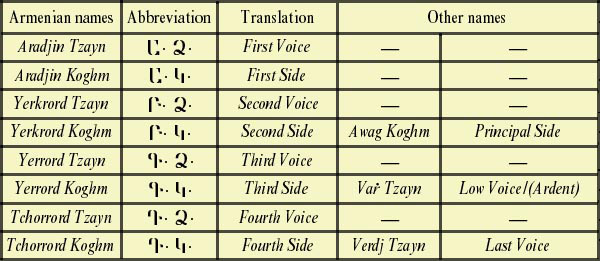

The system of oktoechos (eight voices=eight modes) called oot tzayn in Armenian, is practised in two distinct ways: liturgical and musical. The liturgical oktoechos and the musical oktoechos often function independently of each other. The traditional classification and the denominations of the Armenian oktoechos are the following:

The Armenian letters are used to denote each mode, as found in all liturgical books, musical or not. Neumed manuscripts and printed books, as well as song collections in Modern Armenian musical notation use these same intial letters.
The oktoechos divisions called Voice and Side can be compared to the Byzantine and Latin modal division as authentic and plagal. However, there is no comparable structural link.
The liturgical oktoechos is applied to the calendar through the mode of the day. One of the eight modes is adopted for each day of the year, following the order in which they appear in the chart above.
During the offices, a certain number of elements are chosen according to the mode of the day. This choice especially concerns New Testament readings, the Alleluia, the litanies, prayers and collects, certains psalms and the sharagan.
Easter Sunday is the beginning of the cycle and the mode of the day is First Voice. For this reason, the mode of the day on the first Sunday of Lent becomes Fourth Side, whatever it might have been the day before. From this day on, the mode continues to change daily, so that by Easter Sunday the mode becomes First Voice. Consequently, certain feasts which occur in a fixed period of time related to the Easter date have the same mode of the day every year. The mode of the day may change for other feasts every year, and choice of elements depend both on the mode of the day and on the theme of the day.
On the first Sunday of Lent, when the mode of the day becomes Fourth Side, the four Voices on one hand and the four Sides on the other are attributed to one or the other of the two choirs called Ajagoghmean tas (choir of the right side, at the North of the church) and Tzakhagoghmean tas (choir of the left side, at the South of the church). This attribution alternates every year, on the first Sunday of Lent. This disposition determines which choir will sing certain elements or the Commencement of a sharagan song for the whole year. As for the choice of sharagan, the mode of the day functions only in certain cases, as many feasts have their fixed canon of sharagan songs each of which is composed in a given mode.
The musical oktoechos comprises the modal system which is applied to an important part of the repertoire, the sharagan songs. Apart from this repertoire, the musical oktoechos is only applied to the psalms of the Night office, called ganonaklookh (Canon head).
The modes used in Armenian liturgical chant are not limited to those of the oktoechos. The songs which are not sharagan use modes that are not organized like the modes of the oktoechos and do not have original Armenian names.
In the present-day classifications, each mode of the oktoechos has one or more tartzwadzk‘ modes, a term which can be temporarily translated as auxiliairy. These modes are always named with the principal mode. In neumed books, they can be recognized by the use of some different neumes when compared to those used in the principal mode. It is easier to recognize them in Modern Armenian musical notation, since the signs of this system correspond to degrees.
In almost every mode, there are melismatic sharagan songs. Their melody-types, and sometimes the intervals they use, differ from those of principal or auxiliary modes. Some of these sharagan are known as deviations, others are called sdeghi.
There is no structural relationship between principal and auxiliary modes, nor between these and the other subdivisions. In some cases, a certain affinity can be observed between the modulations they use and the modes used in Ottoman music. In their present state, these modes seem to have been classified by convention in a symbolic system of oktoechos. This fact gives each of the oktoechos modes the character of a mode-family rather than a precise single mode. However, to justify this term, a detailed analysis of the repertoire is needed.
Aram Kerovpyan
© AKN 2005-2025. Reproduction forbidden without authorization.
This website is provided by Symétrie.
Page updated on le 13-12-2013.
Akn
Armenian Modal Chant